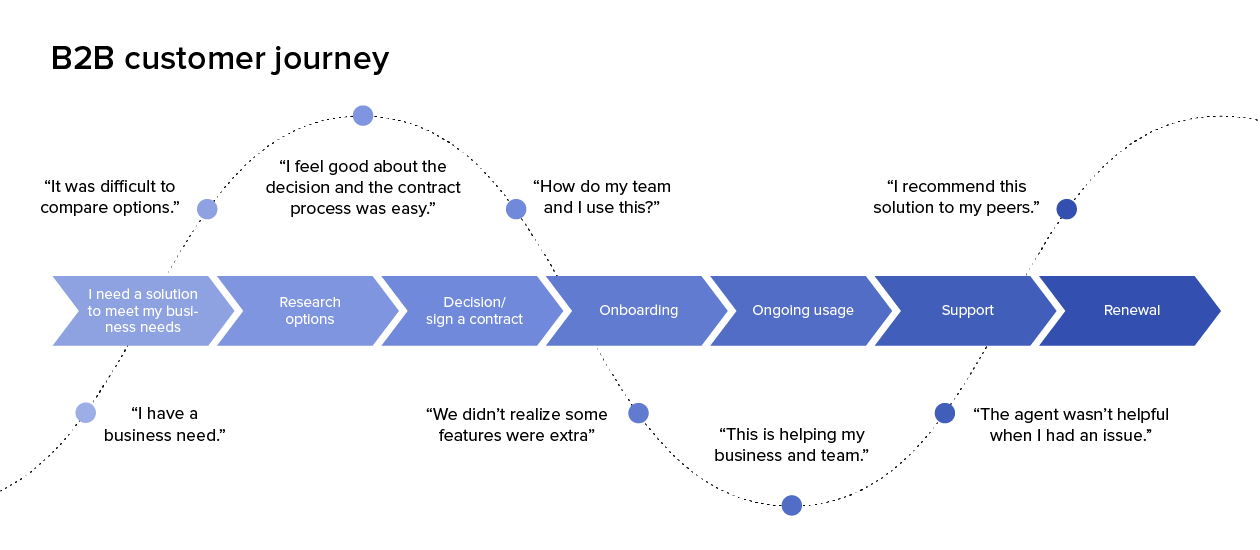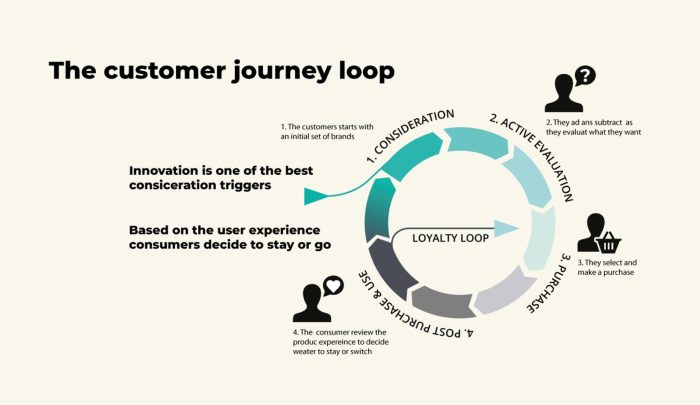Understanding the Customer Journey takes center stage, inviting readers into a world of business insights and customer connections. Get ready to dive deep into the pivotal role of customer journey analysis in shaping successful business strategies.
From unraveling the stages of the customer journey to mapping out key touchpoints, this discussion will equip you with the tools and knowledge needed to elevate customer satisfaction and loyalty.
Importance of Understanding the Customer Journey
Understanding the customer journey is crucial for businesses to improve their marketing strategies and enhance customer satisfaction.
Enhanced Customer Engagement
- By analyzing the customer journey, businesses can identify touchpoints where customers interact with their brand.
- This understanding allows for personalized marketing efforts, leading to increased engagement and brand loyalty.
- For example, Starbucks utilizes customer journey mapping to create personalized offers and recommendations based on customer preferences.
Improved Customer Satisfaction
- Understanding the customer journey helps businesses anticipate customer needs and pain points, allowing for proactive solutions.
- This leads to improved customer satisfaction and loyalty, as customers feel valued and understood.
- Amazon’s use of data analytics to track the customer journey has resulted in faster delivery times and personalized recommendations, enhancing the overall shopping experience.
Stages of the Customer Journey

In understanding the customer journey, it is crucial to identify and describe the different stages that a customer typically goes through when interacting with a business. These stages include pre-purchase, purchase, and post-purchase, each playing a significant role in shaping the overall customer experience.
Pre-Purchase Stage
The pre-purchase stage is the initial phase where a customer becomes aware of a product or service. During this stage, customers may engage in research, comparison shopping, and seeking recommendations from friends or online reviews. For example, a customer searching for a new smartphone may visit different websites, read reviews, and compare features before making a decision.
Purchase Stage
The purchase stage is when the customer decides to make a transaction and buy the product or service. This stage involves choosing the preferred product, completing the purchase process, and possibly interacting with customer service representatives. For instance, a customer finalizing the purchase of a laptop may select the model, add it to the cart, and make the payment online.
Post-Purchase Stage
The post-purchase stage occurs after the customer has made the purchase and received the product or service. In this stage, customers evaluate their experience, provide feedback, and may seek assistance for any issues or inquiries. For example, a customer who bought a new camera may share their feedback on social media, contact customer support for technical assistance, or consider repurchasing accessories.
By comparing and contrasting the pre-purchase, purchase, and post-purchase stages of the customer journey, businesses can gain valuable insights into customer behavior, preferences, and satisfaction levels. Understanding each stage allows businesses to tailor their marketing strategies, improve customer service, and enhance overall customer satisfaction, ultimately building long-lasting relationships with their customers.
Mapping the Customer Journey: Understanding The Customer Journey

Mapping the customer journey involves visualizing the steps a customer takes when interacting with a business, from initial contact to post-purchase support. This process helps businesses understand the customer’s experience and identify opportunities for improvement.
Techniques and Tools for Mapping Customer Journeys, Understanding the Customer Journey
There are several techniques and tools used for mapping customer journeys, including:
- Customer Personas: Creating fictional characters that represent different customer segments to understand their needs and behaviors.
- Customer Surveys: Gathering feedback directly from customers to identify pain points and areas for improvement.
- Customer Journey Maps: Visual representations of the customer’s interactions with the business, highlighting touchpoints and emotions at each stage.
- Data Analysis: Utilizing data from customer interactions to identify patterns and trends in the customer journey.
Importance of Creating Detailed Customer Journey Maps
Creating detailed customer journey maps is crucial for business success because:
- Identifying Pain Points: Helps businesses pinpoint areas where customers may be experiencing difficulties or dissatisfaction.
- Improving Customer Experience: Allows businesses to enhance the overall customer experience by addressing gaps in service or communication.
- Increasing Customer Loyalty: Building strong relationships with customers by understanding their needs and preferences throughout the journey.
- Driving Business Growth: By optimizing the customer journey, businesses can attract new customers and retain existing ones, leading to increased revenue and growth.
Analyzing Touchpoints in the Customer Journey
When we talk about touchpoints in the customer journey, we’re referring to every interaction a customer has with a business before, during, and after a purchase. These touchpoints can occur online or offline and play a crucial role in shaping the overall customer experience.
Key Touchpoints and Their Significance
- Website Visits: A customer’s first impression of a business often comes from visiting its website. Optimizing the website for user experience can significantly influence customer behavior.
- Customer Service Interactions: How a business handles customer inquiries, complaints, or feedback can make or break a customer’s perception of the brand.
- Social Media Engagement: Interactions on social media platforms can impact brand loyalty and influence purchasing decisions.
- Email Marketing: Personalized and targeted email campaigns can nurture leads and guide customers through the sales funnel.
Optimizing Touchpoints for Enhanced Customer Experience
- Personalization: Tailoring interactions based on customer preferences and behavior can create a more personalized and engaging experience.
- Consistency: Ensuring a consistent brand message and experience across all touchpoints helps build trust and loyalty.
- Feedback Collection: Actively seeking and acting on customer feedback can demonstrate a commitment to improving the customer experience.
- Integration: Connecting touchpoints to provide a seamless omnichannel experience can enhance customer satisfaction.
